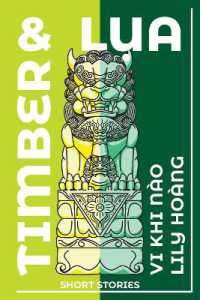Full Description
With a focus on empirical evaluation and practical application, Criminological Theories: Introduction, Evaluation, and Application, seventh edition, helps students draw connections between criminological theory and practical applications. In clear, engaging language, authors Akers, Sellers, and Jennings explore each principal criminological theory using a three-part analysis:The Introduction presents a succinct exposition of the theory's central concepts, assertions, and hypothesesThe Evaluation provides a detailed critique of the theory, with an emphasis on empirical validityThe Application extends the evaluation to determine each theory's relevance and its potential for controlling and preventing crime and delinquency.New to this EditionA new chapter: Developmental and Life-Course Theories (Chapter 14)Substantial updates to Chapter 2. Deterrence and Rational Choice Theories and Chapter 15. Integrating Criminological TheoriesIncreased coverage of Biosocial Theories (Chapter 3)This title is available as an eBook. Please contact your Learning Resource Consultant for more information.
Contents
Each chapter ends with a Summary. PrefaceIntroduction to Criminological Theory What Is Theory? Types of Criminological Theories Theories of Making and Enforcing Criminal Law: Theories of Criminal and Deviant Behavior: Criteria for Evaluating Theory Logical Consistency, Scope, and Parsimony: Testability: Empirical Validity: Usefulness and Policy Implications: Theory and Ideology: Emphasis on Empirical Validity and Application of Theories:Chapter 2. Deterrence and Rational Choice Theories Classical Criminology and the Deterrence Doctrine Deterrence: Certainty, Severity, and Celerity of Punishment: Modern Deterrence Theory Studies of Deterrence: Do Criminal Sanctions Deter?: Deterrence and Experiential Effects: Modifications and Expansions of Deterrence Concepts: Rational Choice Theory Deterrence and Expected Utility: Research on Rational Choice Theory: Deterrence and Criminal Justice Policy Scared Straight, Shock Incarceration, and Boot Camps Routine Activities Theory Felson and Cohen: Offenders, Targets, and Guardians: Empirical Validity of Routine Activities Theory: Routine Crime Prevention and Precautions:Chapter 3. Biological and Biosocial Theories Introduction Lombroso and Early Biological Theories Lombroso's Theory of the Born Criminal: The Criminal as Biologically Inferior: Recognizing the Inadequacies of Early Biological Theories: Modern Biological and Biosocial Theories of Crime and Delinquency: Interaction of Biological and Environmental Variables Neurobiological Approaches to Crime: Genetically Transmitted Criminal Susceptibility: Behavioral and Molecular Genetics: Evolutionary Psychology and Criminality: Empirical Validity of Biological Theories of Criminal Behavior Policy Implications of Biological Theories:Chapter 4. Psychological Theories Psychoanalytic Theory Personality Theory Personality Traits: The Psychopathic Personality: The Five-Factor Model: Psychological Counseling in Delinquency Prevention and TreatmentChapter 5. Social Learning Theory Introduction Sutherland's Differential Association Theory Akers's Social Learning Theory Development of the Theory: The Central Concepts and Propositions of Social Learning Theory: The Social Learning Process: Sequence and Feedback Effects: Social Structure and Social Learning: Empirical Validity of Social Learning Theory Research on Relationship of Criminal and Delinquent Behavior to Social Learning Variables: Research on Social Learning in the Family and Delinquency: Research on Peers and Group Contexts in Crime and Delinquency: Research on Social Structure and Social Learning: Applications of Social Learning Theory in Prevention and Treatment Programs Highfields and Essexfield: The Pinehills Experiment: The Teaching Family Model: Oregon Social Learning Center (OSLC): Andrews's Experiments and Model of Treatment and Prevention: Meta-Analyses of Cognitive-Behavioral Programs: Gang Resistance Education and Training: Other Prevention Programs:Chapter 6. Social Bonding and Control Theories Introduction Early Control Theories Reiss's and Nye's Theories of Internal and External Controls: Reckless's Containment Theory: Sykes and Matza: Techniques of Neutralization and Drift: Hirschi's Social Bonding Theory The Central Concepts and Propositions of Social Bonding Theory: Empirical Validity of Social Bonding Theory: Gottfredson and Hirschi: Self-Control Theory Low Self-Control as the Cause of Criminal Behavior: What Is the Relationship Between Self-Control Theory and Social Bonding Theory?: Testability of Self-Control Theory: Research Indirectly and Directly Testing Self-Control Theory: Hirschi's Social Bonding Modifications of Self-Control Theory: Policy Implications of Control Theories Social Bonding Elements in the Social Development Model: Policy Implications of Self-Control Theory:Chapter 7. Labeling and Reintegrative Shaming Theory Introduction Labeling as a Process of Symbolic Social Interaction The Label as an Independent Variable in Crime and Deviance Empirical Evidence on Labeling Theory Implications of Labeling Theory: Juvenile Diversion Programs Braithwaite's Reintegrative Shaming Theory Reintegrative Shaming, Restorative Justice, and Faith-Based Programs Applications of Restorative Justice: Theory and Philosophy of Restorative Justice: Reintegration and Rehabilitation: Effectiveness of Restorative Justice Programs: The Past and Future of Labeling TheoryChapter 8. Social Disorganization Theory Introduction Early Statistical Studies of Crime Social Disorganization and the Urban Ecology of Crime and Delinquency Research on Social Structure and Crime Rates: Restatements and Research on Social Disorganization Theory: Code of the Street: Community Projects and Policies Based on Theories of Social Disorganization The Chicago Area Projects: Other Policy Implications of Social Disorganization Theory:Chapter 9. Anomie and Strain Theories Introduction Classic Anomie/Strain Theories Merton's Theory of Social Structure and Anomie: Cohen: Status Deprivation and the Delinquent Subculture: Cloward and Ohlin: Differential Opportunity and Delinquent Subcultures: Miller: Focal Concerns of Lower Class Culture: Research on Classic Anomie/Strain Theories Are Crime and Delinquency Concentrated Among Lower Class and Minority Individuals?: Gangs and Delinquent Subcultures: School Dropout and Delinquency: Perceived Discrepancy Between Aspirations and Expectations: Contemporary Anomie/Strain Theories Messner and Rosenfeld's Institutional-Anomie Theory: Agnew's General Strain Theory of Crime and Delinquency: Programs Based on Anomie and Subcultural Theories The Boston Mid-City Project: Mobilization for Youth: Policy Implications of Contemporary Anomie/Strain Theories:Chapter 10. Conflict Theory Introduction Law Is a Type of Social Control: Consensus and Functionalist Theories of Law Conflict Theory of Law and Criminal Justice Empirical Validity of Consensus and Conflict Theories of Law and Criminal Justice Research on Legislation: Research on Public Opinion on Crime and Criminal Justice: Research on Social Threat: Research on Extralegal Variables in Criminal Justice Decision Making: Research on Racial Profiling: Conflict Theory of Criminal Behavior Empirical Validity of Conflict Theory of Criminal Behavior Policy Implications of Conflict TheoryChapter 11. Marxist Theories Marxist Theory Marxist Theory of Law and Criminal Justice Instrumentalist and Structuralist Marxism: Empirical Adequacy of Marxist Theory of Law and Justice Marxist Theory of Crime Bonger: Early Marxist Theory of Crime: Quinney: Class, State, and Crime: Modifications of Marxist Theory: Is Crime the Result of a Capitalist Economy? Policy Implications of Marxist Theory:Chapter 12. Radical and Critical Theories Introduction Henry and Milovanovic: Constitutive Criminology Left Realism Cultural Criminology Peacemaking CriminologyChapter 13. Feminist Theories Introduction Feminist Theories of Criminal Justice Empirical Validity of Feminist Theories of Criminal Justice Feminist Theories of Crime Women's Liberation and Female Crime: Patriarchal Society and Crime: Masculinities and Structured Action: Gendered Pathways and Gendered Contexts: Empirical Validity of Feminist Theories of Criminal Behavior Policy Implications of Feminist TheoriesChapter 14. Developmental and Life-Course Theories Introduction Age and Crime: Criminal Careers: Developmental and Life-Course Theories of Crime Moffitt's Developmental Taxonomy: Loeber's Developmental Pathways Model: Gottfredson and Hirschi's Self-Control Theory: Sampson and Laub's Age Graded Theory of Informal Social Control: Giordano's Life-Course Perspective on Social Learning: Farrington's Integrated Cognitive Antisocial Potential Theory: Policy Implications of Developmental and Life-Course TheoriesChapter 15. Integrating Criminological Theories Theory Competition Versus Theory Integration Varieties of Theoretical Integration in Criminology: Conceptual Integration Akers: Integration by Conceptual Absorption: Cullen and Colvin: Social Support and Coercion: Propositional Integration 284 Elliott's Integrative Model of Strain, Bonding, and Learning: Krohn's Network Analysis: Thornberry's Interactional Theory: Tittle's Control Balance Theory: How Successful Has Theoretical Integration Been in Criminology? References: Author Index: Subject Index:








